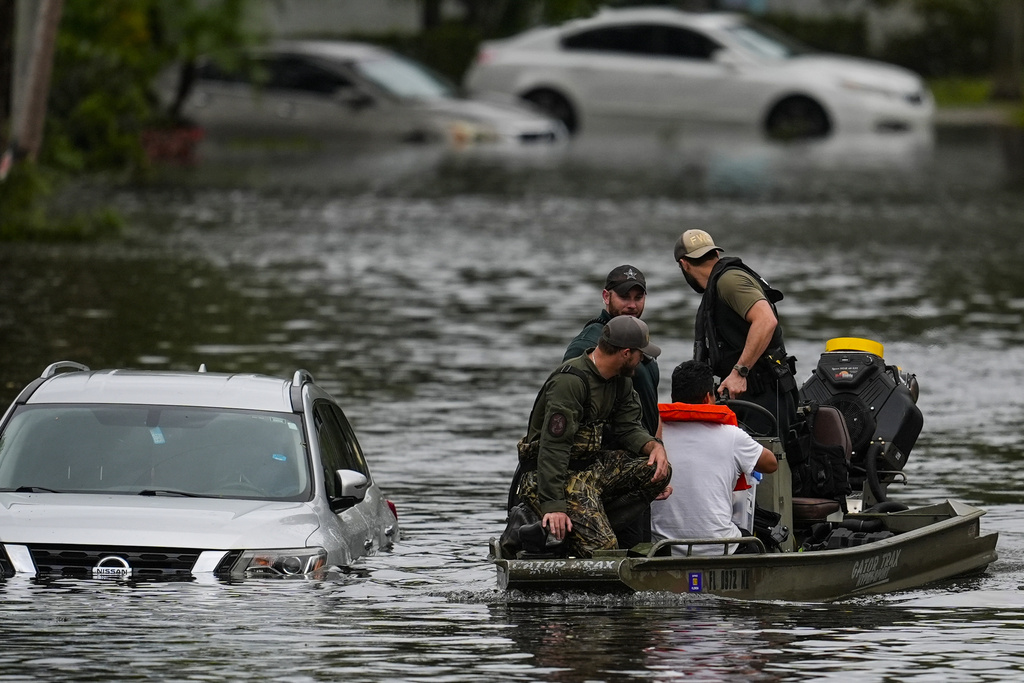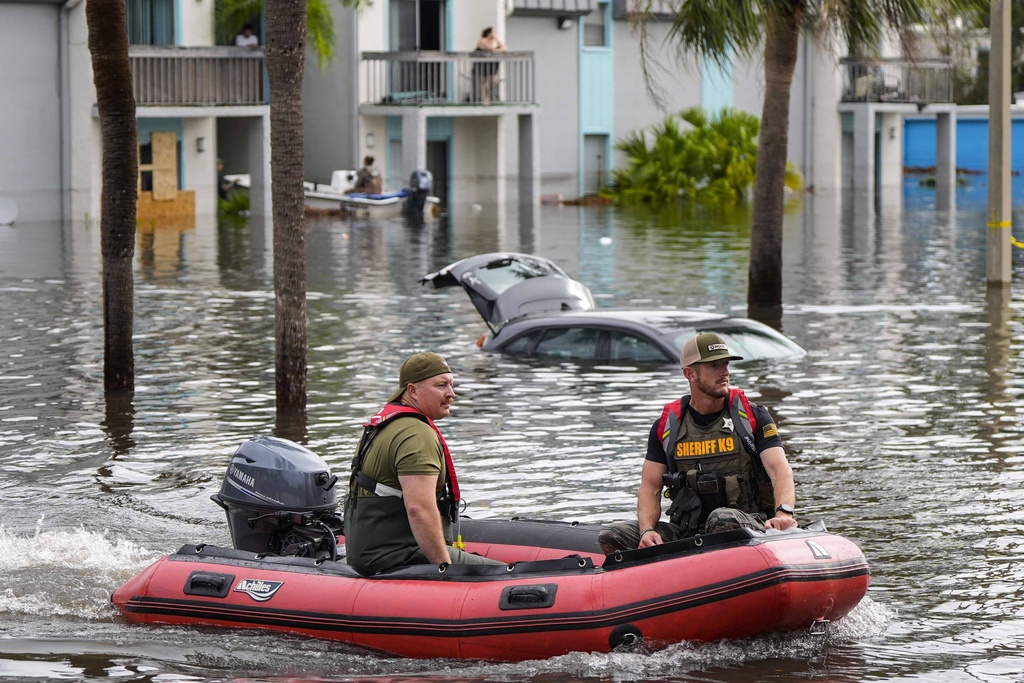Hurricane Milton Leaves Trail of Destruction and 6 Dead in Florida \ Newslooks \ Washington DC \ Mary Sidiqi \ Evening Edition \ Rescue teams in Florida worked to save residents from the devastation of Hurricane Milton, which destroyed homes, caused severe flooding, and triggered deadly tornadoes, killing at least six people. The storm knocked out power to over 3 million customers and wreaked havoc on infrastructure. Despite the damage, residents expressed relief that the storm wasn’t as catastrophic as feared.

Hurricane Milton Rescue Efforts Quick Looks:
- Widespread Destruction: Homes destroyed, streets flooded, and deadly tornadoes reported.
- Dramatic Rescues: A boy was saved from floating debris; a fisherman was rescued from the Gulf of Mexico.
- Power Outages: Over 3 million customers without electricity.
- Governor’s Response: Gov. DeSantis expressed confidence in recovery efforts.
- Tornado Fatalities: At least six confirmed dead, with reports of up to 10 fatalities.
- Infrastructural Damage: Stadium roof torn off, construction crane toppled, and boats displaced.
Deep Look:
Rescue operations intensified across Florida on Thursday after Hurricane Milton tore through coastal communities, leaving a trail of destruction. The storm, which made landfall as a Category 3 hurricane, shattered homes, flooded streets, and spawned a series of deadly tornadoes that claimed the lives of at least six people.
Just two weeks after the devastation brought by Hurricane Helene, Milton added to Florida’s woes, knocking out power to more than 3 million homes and businesses. Among the notable damages, the hurricane tore the roof off Tropicana Field, home of the Tampa Bay Rays, and caused a construction crane to collapse. Barrier islands were inundated, and the storm left behind widespread flooding.
One of the most heart-pounding rescues involved Hillsborough County officers saving a 14-year-old boy who had been floating on a piece of fence. They pulled him onto their boat, providing a rare moment of relief amid the chaos. Elsewhere, a Coast Guard helicopter crew rescued a fisherman who had been clinging to an ice chest after his boat broke down off Medeira Beach just before the storm made landfall.
Although the destruction was extensive, many residents were grateful that Hurricane Milton wasn’t as severe as predicted. The Tampa area was spared a direct hit, and the catastrophic storm surge scientists feared never materialized. Milton veered south in the final hours, making landfall late Wednesday in Siesta Key, approximately 70 miles south of Tampa. While the storm caused widespread damage and water levels may continue to rise in the coming days, Florida Governor Ron DeSantis reassured the public that it was not the “worst-case scenario.”
Speaking in Sarasota, DeSantis acknowledged the challenges faced by the state, saying, “You face two hurricanes in a couple of weeks — not easy to go through — but I’ve seen a lot of resilience throughout this state. I’m very confident that this area is going to bounce back very, very quickly.”
The hurricane’s wrath extended far beyond Siesta Key. On Florida’s Atlantic Coast, five people were killed by tornadoes in the Spanish Lakes Country Club near Fort Pierce. In another incident, a woman was found dead under a fallen tree branch. During a White House briefing, Homeland Security Secretary Alejandro Mayorkas reported up to 10 possible tornado-related fatalities, although this number remained tentative.
By Thursday afternoon, Governor DeSantis announced that at least 340 people and 49 pets had been rescued as efforts continued across the state. Some of the hardest-hit areas included the counties of Hillsborough, Pinellas, Sarasota, and Lee, where officials warned residents to stay home due to hazards like downed power lines, blocked bridges, and dangerous flooding.
In Palmetto, south of Tampa, Natasha and Terry Shannon narrowly escaped disaster after their cinder block home’s tin roof was ripped off by the hurricane’s winds. Fortunately, they had evacuated to a shelter with their three children and two grandchildren in time. “I said, ‘Baby, we got to go. Because we’re not going to survive this,’” Natasha Shannon recalled. When they returned, they found the roof torn into pieces and their possessions waterlogged. “It ain’t much, but it was ours,” she said tearfully. “What little bit we did have is gone.”
Sarasota County saw the worst of the storm surge, reaching 8 to 10 feet—still lower than the surge caused by Hurricane Helene. Some areas received up to 18 inches of rain, adding to the flooding woes. In Matlacha, a small barrier island off Fort Myers, the community experienced severe damage from both a tornado and a surge. Tom Reynolds, 90, spent his morning clearing out four feet of mud and water from his home while collecting fragments of aluminum siding that had been torn off by the twister. A car had been lifted by the storm and thrown across the street.
Elsewhere on the island, homes were either swept away or set ablaze. Yet, despite the widespread destruction, residents like Reynolds were determined to rebuild. “What else am I going to do?” Reynolds said, resolving to repair the house he built 30 years ago.
In stark contrast, workers on Anna Maria Island expressed relief that they weren’t dealing with the extensive floodwaters they had faced during Hurricane Helene. Just two weeks earlier, Helene had ravaged the island, dumping six feet of sand and leaving homes buried in debris. City worker Kati Sands commented on the scene Thursday morning, saying, “I’m shocked it’s not more. We lost so much with Helene, there wasn’t much left.”
As recovery efforts get underway, the reality of power outages continues to affect millions. At the peak of the storm, more than 3.4 million homes and businesses were without electricity, according to poweroutage.us. In addition to homes and businesses, significant infrastructure was damaged, including Tropicana Field’s fabric roof, which was torn apart by fierce winds, leaving debris scattered across the baseball field.
In Punta Gorda, the historic district faced a 10-foot storm surge from the Peace River, damaging homes and displacing boats. Josh Baldwin, whose 38-foot boat was destroyed, was considering scrapping it rather than paying the $100,000 needed for repairs, especially given the difficulty of securing insurance in the hurricane-prone area.
By Thursday afternoon, Hurricane Milton had weakened into a post-tropical cyclone as it moved into the Atlantic, with winds reduced to 75 mph. Despite the storm’s ferocity, some areas were left counting their blessings. Anna Maria Island Police Chief John Cosby, crossing the bridge from the mainland early Thursday, breathed a sigh of relief as he confirmed that no injuries or fatalities had occurred in his area. “It’s nice to have a place to come back to,” he said.
Hurricane Milton Leaves Hurricane Milton Leaves Hurricane Milton Leaves







